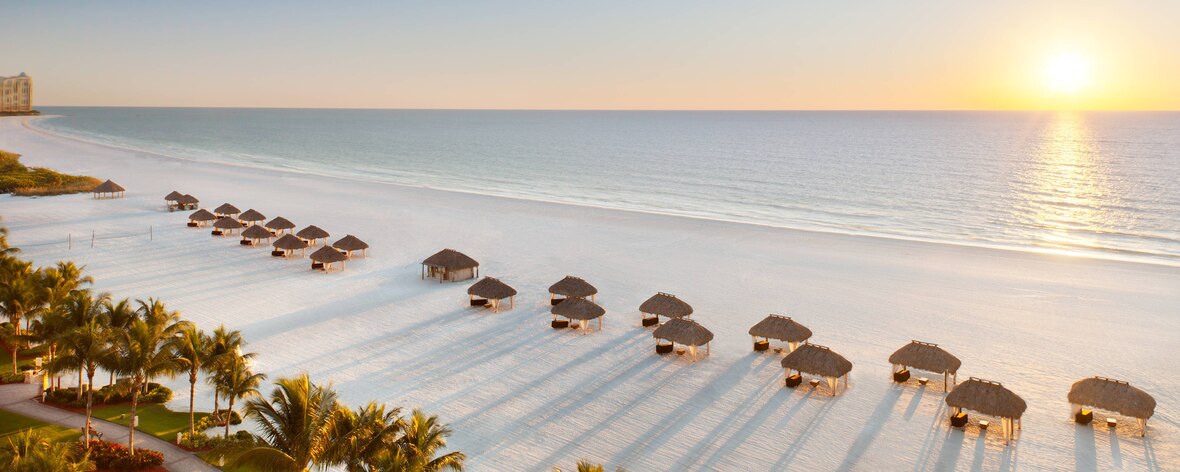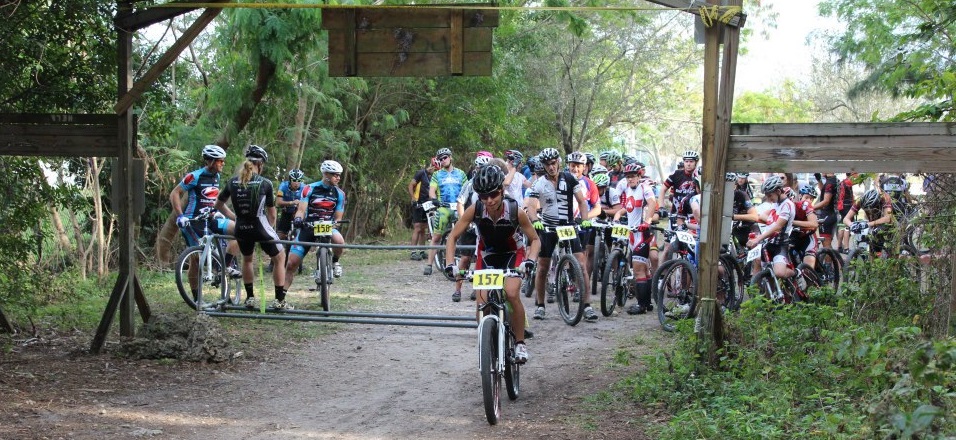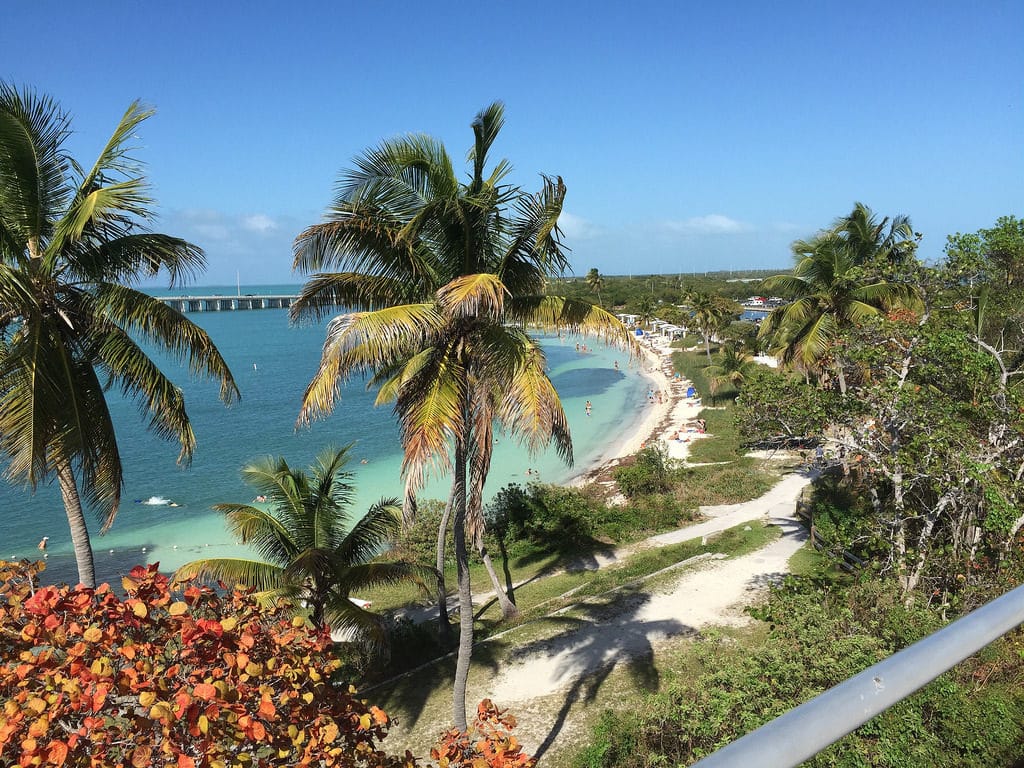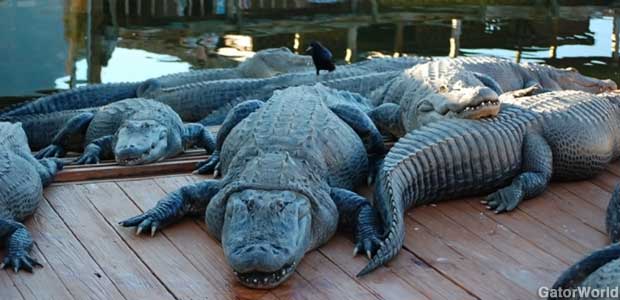
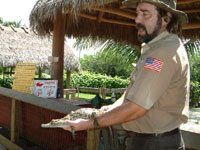
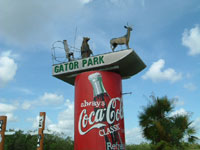
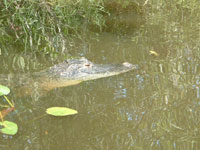
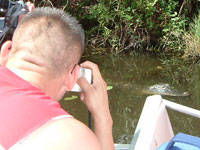

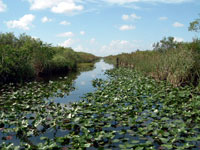

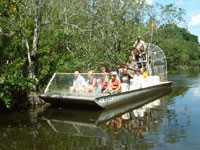
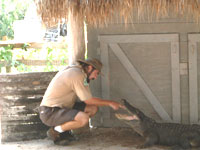

Everyone has heard of the Everglades. Most people know that it’s an endangered environment. Even so, we all need to experience the beauty of the place and learn of the good that it does us in Florida and beyond in order to ensure that we don’t loose sight of its importance. A fantastic way to obtain a solid understanding of this incredible ecosystem is by visiting Gator Park. Its here that visitors can take a diverting airboat ride, see some local and non-local animals, and best of all, walk away with a better appreciation of this place called the “River of Grass”.
At Gator Park, Captain Glenn welcomed us all, and wasted no time collecting us onto the airboat. He helped us enter the strange contraption and handed out earplugs that we were all grateful for later. The noise from the propellers is outrageous. Captain Glenn is a genuine lover of the Everglades. He even has his own website, www.aaof.us, where he states, “Nature Rules”! Captain Glenn’s nickname is Gator Man, appropriately named since he has a knack with these beautiful but misunderstood animals. As soon as we departed from the dock, Captain Glenn yelped, and a decently sized alligator came out to greet the airboat. He proceeded to describe the American Alligator. He says that the habitat range of the American Alligator extends south from coastal swamps in North and South Carolina to the tip of southern Florida, then west along the Gulf Coast to the mouth of the Rio Grande. Alligators roam inland throughout the southern coastal flatland. They live in freshwater lakes, rivers, and swamps, and occasionally reside in brackish water.
The largest alligator ever recorded in Florida was 17 feet 5 inches long. The largest alligator ever recorded anywhere measured 19 feet 2 inches and was found in Louisiana. The growth rate of alligators varies with food availability and temperature. At the northern limits of its habitat, or when food is scarce, alligators grow slowly. In Louisiana, where food is abundant, young alligators can grow about one foot per year with the greatest growth in the first year. The weight of an alligator in relation to its length can vary greatly. One 11 foot 6 inch alligator weighed 591 pounds, whereas another alligator measuring 12 feet 1 inch weighed only 460 pounds.
Alligators eat a wide variety of foods including insects, crabs, crayfish, fish, frogs, snails, turtles, snakes, coots, grebes, wading birds, raccoons, otters, deer, and other alligators. The creatures are also known to eat dead animals. Although alligators are carnivorous, they are occasionally seen uprooting vegetation. Evidently they do not eat the plant material, but may be catching crayfish, snails, and insects living in the mud at the base of the plants. Alligators feed most often when temperatures are between 73-90°F. If prey is small, it may be swallowed whole. Otherwise the gator will bite down on it repeatedly. Using a combination of sharp teeth and tremendously strong jaw muscles, it breaks bones or shells so the whole item can be swallowed. Large prey may also be shaken vigorously and slapped against the water or shore to rip off swallow-sized pieces. Alligators roll underwater with very large prey, submerging the victim and drowning it. The dead prey is dragged around or guarded for several days until the meat rots enough to be ripped apart.
Alligators are cold-blooded, which means that their body temperatures fluctuate in response to the temperature of their surroundings. An advantage of being cold-blooded is that little energy needs to be spent in maintaining a high body temperature, and therefore less food is needed. A healthy alligator can go many months without food. Alligators can survive in water temperatures as cold as 36°F and as warm as 98°F, however they function best within a relatively narrow range of temperatures.
After his informational talk, Captain Glenn turned up the throttle of his engine and with a big “swoosh” we were out of the canal and into the “River of Grass.” It’s amazing how the airboat skims across the shallow water. Some spots are only 6 inches deep, and still, the boat doesn’t get stuck. Captain Glenn slows and stops the airboat periodically to explain more about the Everglades. He tells us the Everglades is really a river. He illustrated that if you look at a map of Florida, you will see a huge mass of water below Orlando. It averages 12 feet deep and covers 730 square miles. This body of water is Lake Okeechobee, which fills with rain water during Florida’s rainy season. The lake’s water flows down to the shallow Everglades. Fifty miles wide in places, one to three feet deep in the slough’s center but only 6 inches deep elsewhere, these waters flow south 100 feet per day across Everglade’s saw grass, toward mangrove estuaries of the Florida Bay and Gulf of Mexico.
Everglade’s plants and animals are adapted to alternating wet and dry seasons. Water cycle disruptions ruin crucial feeding and nesting conditions. During the dry season (December to April), water levels gradually drop. Fish migrate to deeper pools. Birds, alligators, and other predators concentrate around the pools to feed on a varied menu of fish, amphibians, and reptiles. This abundant food source is vital to many wading birds that are nesting during the dry season.
In May, spring thunderstorms signal the beginning of the wet season. A winter landscape dotted with pools of water yields to a summer landscape almost completely covered with water. Wildlife disperses throughout the Everglades. Insects, fish, and alligators repopulate the ‘glades, thus replenishing the food chain. By December, the rains cease and the dry cycle begins again.
Slight changes in elevation (only inches), water salinity, and soil create entirely different landscapes, each with its own community of plants and animals.
The Everglades is a low, flat plain shaped by the action of water and weather. In the summer wet season it is a wide, grassy river. In the winter season the edge of the slough is dry grassland. Though Everglades National Park is often characterized as a water marsh, several very distinct habitats exist within its boundaries.
Once Captain Glenn finished teaching about this lush and vast body of land and water, he continued on with the airboat ride. He glided around hairpin turns and put a big smile on everyone’s face with the wind rushing by. Captain Glenn sat upon his high perch and seemed un-phased by the speed at which he was cruising. You could tell he had done this many times. After a 15 – 20 minute ride we returned to the dock. Captain Glenn gave us time to ask him questions, and he kindly thanked us for our time on the airboat.
At the dock, he directed us to the animal educational show held on the grounds of Gator Park. All the attendees of the airboat strolled over to the amphitheater where another guide introduced us to a large captive alligator, and a small baby alligator that we were all able to hold. The group also had the opportunity to observe other local creatures of the Everglades, like toads, scorpions, a baby crocodile, and a skunk. This educational briefing was entertaining and an outstanding way to end a visit to Gator Park.
Getting to Gator Park is interesting because you leave the Florida Turnpike in Miami where you see a plethora of buildings and homes, and you go west on SW 8th Street. You might think to yourself…”What are they talking about, the Everglades aren’t out here,” when all of sudden the structures disappear and the grass of the Everglades appears on the horizon. It is interesting how nature and man are divided. The government just says, “Here the buildings will stop, and nature will begin.” I know if man had the opportunity, he would build right on top of the Everglades. Thank goodness for these regulations.
Florida State Road 41 will take you to the entrance of Gator Park. A day trip down State Road 41 is very enjoyable. It’s the original road that connects east Florida to west Florida. This is the Florida I really appreciate. The people that live in this part of tropical Florida are the real lovers of nature. They love the heat, sweat, animals, and even the pesky insects. Nothing ever seems to bother them.
As you approach Gator Park, you can’t miss it. You’ll spot a huge Coca Cola sign outside with an airboat on top. I pulled in and made my way to the office and gift store to be greeted by the park’s friendly staff.
It’s great that we still have locations like Gator Park; places that teach us the importance of our precious resources, like the Florida Everglades. Hopefully, it will make it to greet future generations to come.
Gator Park
24050 SW 8th Street
Miami, FL 33187
800- 559- 2205
www.gatorpark.com
There is a nice gift store and restaurant to eat on the property.
Great hint: Go to Gator Park’s website and get a saving coupon and free gift!
Gator Park is open everyday! Rain or Shine!Hours:
Monday – Sunday from 9:00 a.m. to 6:30 p.m.
Last show begins at 5:00 p.m.Rates:
Adults: $17.99 Children: $9.99
(Includes park admission, airboat ride, and Wildlife show)
Visa, Mastercard, American Express, Discover and Diner’s Club cards accepted.
Local Eats
“ The Pit Bar-B-Q”
This place has been around for a long time. It has great local B-B-Q and an authentic local atmosphere.
11am – 10pm
16400 SW 8th Street
Miami, FL
305-226-2272
Places to Stay
If you have a camper, you can stay on the grounds of Gator Park for $30 a day.
The closest hotel with A/C is the Miccosukee Resort and Gaming. If you ignore the gaming and just stay for a night, it’s not that bad.
500 SW 177th Avenue
Miami, FL 33194
877-242-6464
Get More Information on This Adventure!!!
Experience adventures like the one found in this article and others by using TropicalAdventure.com Vacation Planner. Simply fill out our Vacation Planner form and you will receive FREE information about this activity and others that you may be interested in. Click below to sign up.

